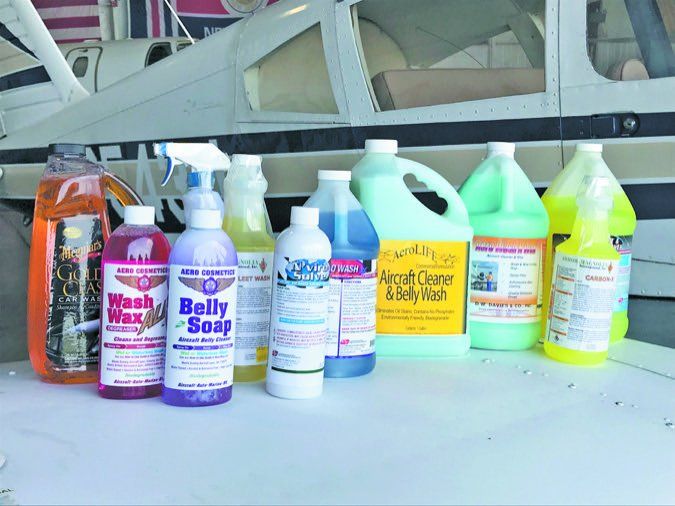Let’s not over think this. Picking a wet-wash product to clean the aircraft isn’t much different than selecting one to clean your vehicle. If you trust it on your cherished Harley-Davidson or show-car paint and accessories, there should be equal confidence using it on the Bonanza. It should be gentle enough to hit everything, including the Plexiglas, not have corrosive properties and rinse off easily.
But there are an overwhelming number of aircraft-specific wet-wash products to choose from. Do a search for wet washes on popular aircraft supply websites and you’ll understand. Wet washes are just that—dilute the soap with water in a wash bucket and go to town with a wash mitt or mop. Suds are a must.
We rounded up 11 products, including ones advertised to clean grime, grease and stains. The results were surprising.
Wash Day
An advocate of regular washes to keep the custom paint schemes for which you invested big looking spiffy, Craig Barnett at Scheme Designers graciously helped organize our wash trial, while Air Bound Aviation at Essex Country airport in New Jersey kindly and bravely let us use one of its water- and floor-drain-equipped hangars.
Carefully plan where you’ll wash. Before opening the spigot, understand the local rules for washing because dedicated wash bays may be your only option. Yes, we know operators who bend the rules, too.
Wear anti-slip footwear that provides solid footing. You’ll likely be working with stepladders, perhaps while balancing wash brushes that can damage control surfaces and antennas should you slip. The hangar floor gets slick. Ours was slickened from runoff and nine overflowing wash buckets filled with the proper mixture of soap and water. As we learned, some of the stronger washes work best when undiluted, while serious degreasing and stain removal mean applying the cleaner straight from the bottle. We tried those first.
Break Out the Sharpies
Yes, Barnett let us write on his Cherokee with Sharpie pens so we could mark, label and test individual areas when spot cleaning, easily comparing surfaces after they dry. (Turns out the airplane was going in for a fresh paint job later that afternoon.) We didn’t write on the hangar-kept Baron 58, which had original paint from 2001, or the slimed-up TKS-equipped T210 also used in the evaluation.
Before trying the wet-wash products, we tried four products marketed as heavier-duty stain and grime removers. You know, the layer of nasty oil and grime that builds on the belly around exhaust stacks, landing gear components and under control surfaces.
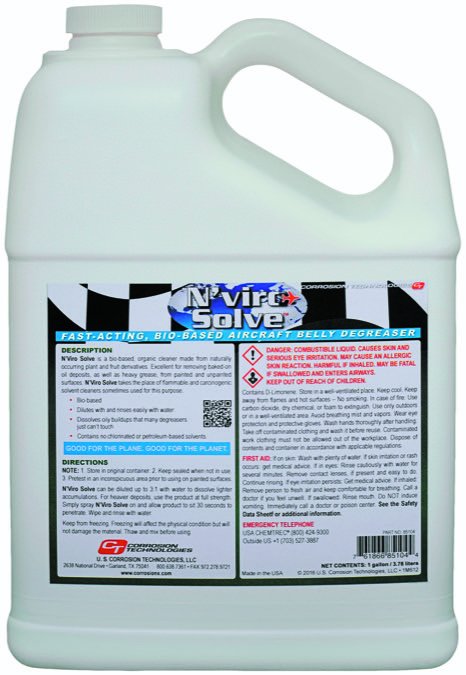
The products we selected were Extreme Simple Green Aircraft cleaner, Aero Cosmetics Belly Soap, Corrosion Technologies N’viro Solve and Arrow-Magnolia Carbon-X. While using them, we looked for the product’s ability to easily clean around rivet heads, metal seams, antennas and plenty of other areas you’ll be cleaning if you want to truly wash the aircraft properly. In doing so for the first time, you’ll understand why some owners pay to have their aircraft washed. It’s a lot of work and requires a lot of time.
First up was Extreme Simple Green aircraft and precision cleaner. Unlike the company’s regular cleaner, the Extreme blend for aircraft meets a variety of non-corrosive cleaning specifications, including the Boeing spec for regular aircraft cleaning. It’s available in multiple quantities, but we used the $15.95 (from Sporty’s) spray-on container bottle for applying it directly to a section of the belly on the Cherokee and to an area on the Baron’s landing gear door, let it soak and then wiped it off with a clean cloth. The biodegradable cleaner is advertised to not leave residue. It left some (taking several applications to dry clean), but did a good job of cleaning belly grime, penetrating under rivet heads and inside seams. The cleaner was also a go-to for grimed-up antennas.
The drill here is to spray the antenna, let it soak and then agitate the surface with a sponge or cleaning brush. Use caution not to put too much pressure on antennas, plus cleaning them will be much easier if you frequently wipe them with a spray-on dry wash.
We were impressed with the Corrosion Technologies (the same folks that sell the CorrosionX treatment) N’viro Solve. This is a bio-based organic cleaner made from natural fruit and plant derivatives. Unlike the Extreme Simple Green, it required a single application on a section of the Cherokee’s grimed-up belly. We sprayed it on undiluted, let it sit for 30 seconds and wiped it clean, where it cleaned around rivets and seams with limited rubbing effort.
But on the Baron the N’viro solve wouldn’t touch a sooty area under one of the wing flaps with one application. After several tries, it finally cleaned the surface and left no residue, but all of our observers noted a slight brown appearance in the area cleaned. A 16-ounce trigger spray bottle is around $20 from Amazon.
Aero Cosmetics Belly Soap is intended to clean aircraft bellies and engine areas coated with baked-on hydraulic fluid and oils. Spray it on, let it sit for a minute and wipe it clean. For heavier grime, you can agitate it with a scrubber (we used the Aero Scrubber tool the company sent us), rinse and let it dry. It worked we’ll on the Cherokee belly, leaving the surface clean with limited residue. It also worked we’ll around rivets. On the underside of the Baron’s sooty flap, the Belly Soap was again easy to work with, but our observers didn’t think it left the surface as clean as the Carbon-X (next page) and Extreme Simple Green. The difference was the Cherokee’s belly was moist with grease, while the Baron’s flap was stained. A half-gallon of Belly Soap is $39.95. It can be used while wet washing or simply sprayed on a dry surface. The Wash Wax All Degreaser is a heavier-duty version of the company’s dry wash. We won’t cover dry washes here, but it worked we’ll when sprayed on dirty antennas and can be applied wet.
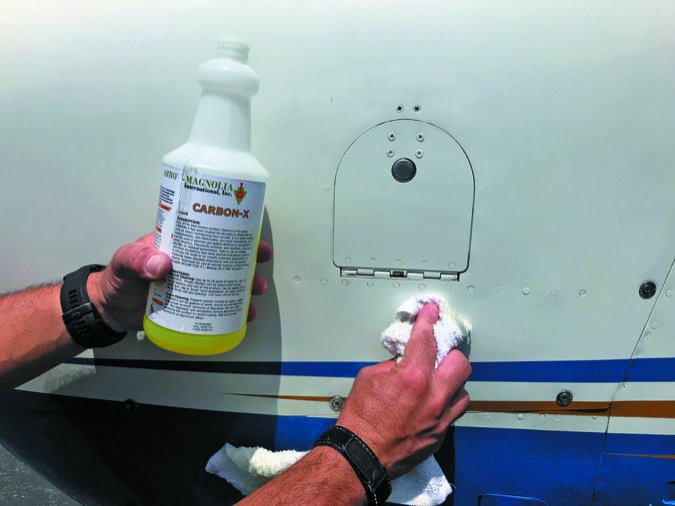
Finally is the popular Carbon-X stain remover from Arrow Magnolia, which sells for $24.95 (one gallon) at Sporty’s. It’s a water-soluble, biodegradable, nonflammable and non-toxic cleaner that meets both Boeing and Douglas Aircraft specs for external cleaning.
The instructions for using Carbon-X call for using one part water to one part Carbon-X, which we mixed in a wash bucket. The cleaner can be applied with a spray gun, with a brush or with a rag, although the instructions suggest applying it by hand for heavily built-up areas of grime. It can also used when steam cleaning by using one gallon of Carbon-X per 60 gallons of water. We followed the instructions and simply hosed it off after ragging it on. On the Cherokee’s belly the diluted Carbon-X was mostly ineffective.
We double-checked the instructions to be sure we didn’t goof (free a bunch of guys from their spouses on a Sunday—in the hangar, with a water hose—and things indeed get goofy). Turns out the solution was mixed properly, but the instructions do say that proper dilution can be determined through actual practice and use of the product. That’s all Barnett needed to hear, so he applied the Carbon-X again, but this time undiluted. In doing so, it left the surface of the belly cleaner than any of the other products. It did a great job around the rivets and seams. Moreover, there was much less mess by applying it straight from a rag instead of applying it after mixing it with water.
On the Baron’s gear door and flap, undiluted Carbon-X easily beat the other cleaners with a single application. It also worked the best at ridding the bugs from the Baron’s nose, although it wouldn’t penetrate the radome, where bugs are there to stay.
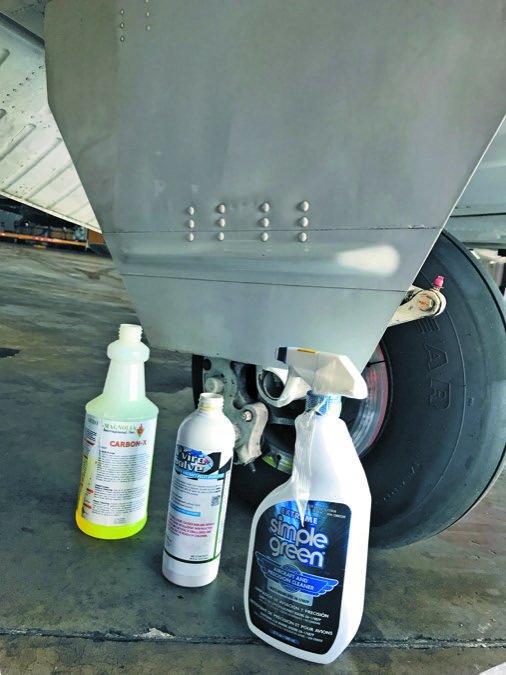
We also used the Carbon-X to wipe some staining off the side of the T210’s cowling, where it made the area clean with little effort. But there’s a caveat, and it applies to any of the heavier-duty cleaners and degreasers we tried: They’ll remove paint—more easily on aging and oxidized paint.
We reached out to field support leader Richard Giles at Sherwin-Williams Aerospace Coatings who basically asked why we were even using these stain removers and degreasers on the paint’s stripes in the first place.
“The secret to good aircraft paint maintenance is regular care, rather than once-per-year aggressive detailing,” he told us. Giles attests that many of the aviation-branded cleaners are quite good at dissolving carbon, but the key is to not attack the paint surface. The best practice is once you remove the contaminants with a thorough cleaning, the next step is to polish and buff the surface so it’s as slick as possible. This fights off future adhesion and ingress/etching of the paint, which gradually wears it down.
Giles even suggested a natural or synthetic clay bar treatment on some oxidized areas. If you’re familiar with automotive paint work and advanced detailing, you’ll know this is the process of using a highly elastic resin mixture to remove pollutants and contaminants from the paint surface.
The bottom line? Maintain the paint surface so you don’t have to use degreasers and strong cleaners on a regular basis. That brings us to the first step: cleaning with a wet wash.
Time To Get Wet
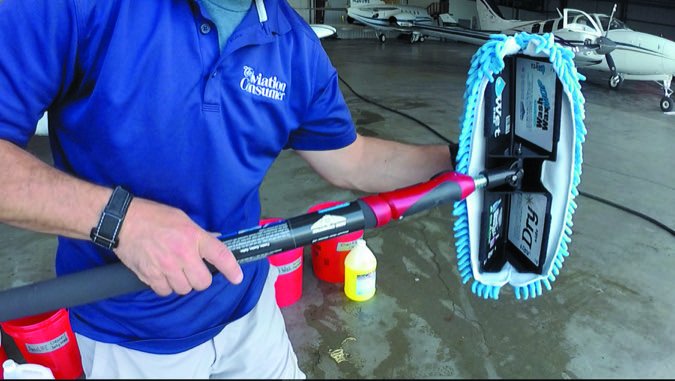
We properly mixed, labeled and lined up the wash products in 5-gallon wash buckets, using soft wash mitts to hand-wash the surfaces. After rinsing with the hose, we dried the surface with PVA (Poly Vinyl Alcohol) The Absorber drying towels. These are around $10 each, are extremely absorbent and work we’ll for drying and cleaning. They won’t glide across the finish, but they make drying a snap.
We were particularly interested to see how the wet washes would work on the T210 when it was slimed up with TKS de-icing fluid. This is the ethylene glycol-based fluid that seeps and runs back from thousands of laser-drilled holes in titanium panels on the leading edges of the wings and tail. We sent the T210’s owner Scott Dyer around the patch and he brought back a big, slimy, dripping hot mess.
The $28 per gallon Aerolife Industries biodegradable aircraft cleaner and belly wash is advertised to eat oil and eliminate stains. It cleaned all of the surface dust, dirt, bird droppings and visible de-ice fluid, but we were disappointed at the lack of suds it made. Yes, lots of suds are important.
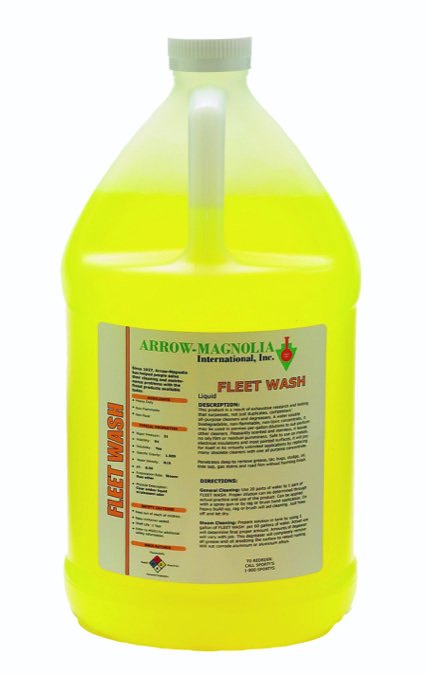
At $25 per gallon ($15 for a half gallon), the Corrosion Technologies Pro Wash RX is a concentrated pH-balanced shine-enhancing soap that’s said to make long-lasting sudsy foam with more shine and fewer streaks. While it did clean the surfaces, it didn’t make enough suds unless we hit the bucket with periodic blasts of water. More than one tester didn’t get the sense it was cleaning because there weren’t enough suds on the surface, although it did clean after washing and rinsing twice. On areas heavily contaminated with TKS fluid, we noticed streaking, which indicated that perhaps not all of the fluid was being removed.
Arrow-Magnolia’s Fleet Wash is $30 per gallon and advertised to penetrate deep to remove bugs, grease and other contaminants. It made lots of beautiful suds and left a brilliant shine after rinsing and drying. It also seemed to more easily wash away the de-ice fluid without leaving behind any film.
Aero Wash N Wax from D.W. Davies & Co. (shown lower left on this page) made enough suds for our liking, was easy to rinse away and shined after drying. But it also removed some paint when we scrubbed the blue stripe on the Cherokee. At around $11 for one gallon, it’s the least expensive.
We tried the Xhaust & Soot Remover wet wash product from Corrosion Technologies, which can be applied undiluted for cleaning soot or mixed with water for lighter-duty general cleaning. It worked we’ll at removing bugs, but as we expected it didn’t leave as brilliant a shine as most of the other products. If your aircraft is parked in a dirty environment, this might be the stuff to keep on hand.
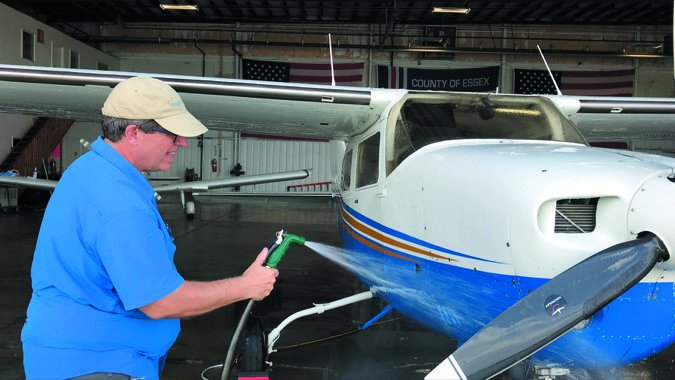
Last, our wet wash trial wouldn’t be complete without trying the go-to wash for our motorcycles and cars: Meguiars Gold Class car wash and conditioner. We’re glad we did. It made lots of suds, worked nearly as we’ll as the others, left an impressive shine and it was easy to rinse off. Others we talk with have good results using the Mothers California Gold wash.
Our Takeaway
We walked away believing all of these products—including a quality car wash or even liquid soap you’d use on Grandma’s china dishes—work we’ll enough for cleaning light surface dirt, pollen and bird droppings. As noted, washing just isn’t enough. You’ll need to polish and keep up with areas that collect grime and soot.
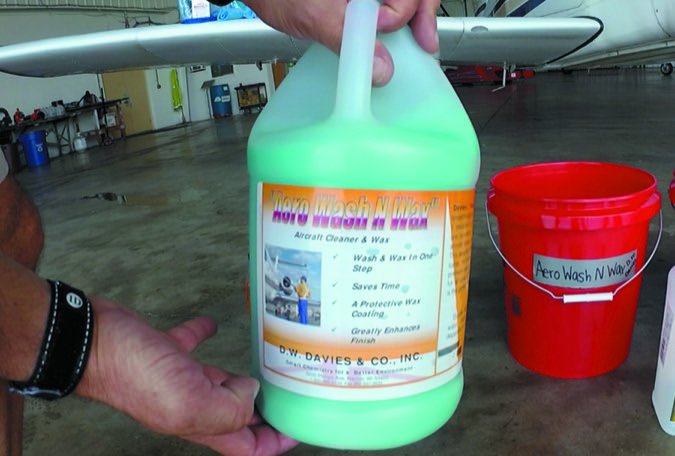
If we had to pick a favorite aircraft wet wash, it would have to be Arrow-Magnolia’s Fleet Wash for its deep cleaning qualities, followed by Davies Aero Wash N Wax for the slick coating it leaves behind. That makes subsequent cleaning easier. For tough stains and soot, Carbon-X and N’viro Solve win. We’ll look at polishes next.
| SELECT WASH PRODUCTS COMPARED | ||
| PRODUCT | STREET PRICE | COMMENTS |
| STAIN TREATMENT/DEGREASERS | ||
| CARBON-X | $24.95 one gallon | A top performer for stain removal, but most effective when used undiluted. Works we’ll on rivet lines. www.arrowmagnolia.com |
| EXTREME SIMPLE GREEN | $15.95 32 ounces | Leaves some residue, requiring a second application and wiping. Works we’ll on antennas and around rivets. www.simplegreen.com |
| N’VIRO SOLVE | $14.95 16 ounces | Spray it on undiluted and in our evaluation it required just a single application and wiping, leaving surface clean. www.corrosionx.com |
| BELLY SOAP | $13.95 16 ounces | Spraying it on and agitating with a scrubber works best. Cleaned soot, but not as we’ll as the others. www.aerocosmetics.com |
| WASH WAX ALL DEGREASER | $9.95 16 ounces | A stronger version of the Wash Wax All spray-on dry cleaner that can be used dry or wet. www.aerocosmetics.com |
| WET WASHES | ||
| PRO WASH RX | $24.95 one gallon | Washes away dirt, but we wanted more suds. Some areas soiled with de-ice fluid needed several washes. www.corrosionx.com |
| Aerolife cleaner/belly wash | $28.21 one gallon | Didn’t make enough suds, left slight streaks in areas heavily contaminated with de-ice fluid. www.aerolifeindustries.com |
| AERO WASH N WAX | $10.84 one gallon | Makes plenty of satisfying suds, seemed easy to rinse off, left an impressive shine. www.dwdavies.com |
| FLEET WASH | $21.95 one gallon | Easily washed away de-ice fluid, plenty of suds, leaves a smooth and shiny finish. www.arrowmagnolia.com |
| XHAUST & SOOT REMOVER | $20.95 one gallon | Not much of a shine, but effective for exhaust soot. Use undiluted for stains or diluted 20:1 with water for general washing. www.corrosionx.com |
| MEGUIARS GOLD CLASS | $10.99 64 ounces | Worked as we’ll as the aviation cleaners, plenty of suds and left a shine. www.meguiars.com |

